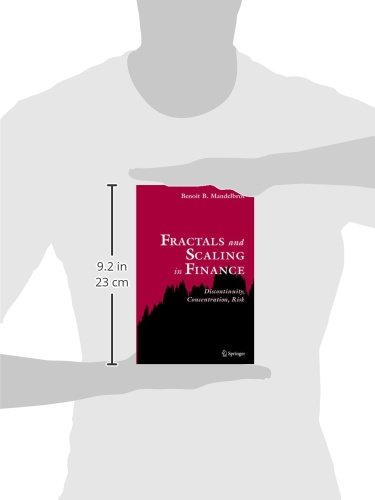



Fractals and Scaling in Finance: Discontinuity, Concentration, Risk. Selecta Volume E
J**H
Very Helpful
Found the papers contained in the book filled in many of the blanks I had after reading some of the other Mandelbrot books. the math was tractable and not too difficult for a non expert. Overall, I would recommend this book to those wanting to get a better understanding of scalability and a basis for mild, soft and wild randomness.
D**D
How nature repeats itself in the markets.
An eye opener. Detailed, but at the same time quite easy to follow.
M**Y
A clear warning to all those financial analysts using N(0,1)
This book deserves to receive 6 stars.Mandelbrot serves up overwhelming empirical,statistical,and historical evidence that financial decision makers are dead wrong in assuming,contrary to the available evidence, that a normal probability distribution describes the outcomes accurately in financial markets .In fact,the Cauchy distribution is substantially more relevant than the normal distribution.Mandelbrot's work simply means that the standard theoretical models taught in all colleges and universities,the CAPITAL ASSET PRICING MODEL(CAPM) and the BLACK-SCHOLES equation, give correct answers if and only if the relevant probability distributions about the movement of prices in financial markets over time are all normal.However, the evidence shows that they are NOT normal.Mandelbrot confirms ,by massive data analysis, Keynes's original 1921 objections to the misuse in application of (by merely assuming the applicability of such a distribution without examining the actual data)the normal probability distribution made in chapters 29 and 30 of the A Treatise on Probability(1921).Unfortunately,it appears that little,if any ,of Mandelbrot's scientific approach and analysis is being integrated into economics and finance.
M**I
Civitas Dei is different from Civitas Diaboli
Mandelbrot is always very bright. A pleasure to read. However...The subject "per se" is quite irrelevant. Of course we know that a fractal is quite crazy, we know also that the walk of a particle subject to brownian motion is quite crazy. And we know that price is quite a crazy variable. Only, trying to predict price behaviour by means of other "crazy" behaviours is nonsense.
H**N
Research oriented book
This was an interesting perspective from Mandelbrot about the inept models already used in the financial industry. I would love to find time to try these new ideas out in my models.The book is quite technical and is really a collection of many research papers. So it is not for those who don't like calculus in their face.
S**R
Typical Mandlebrot
The good side of Mandlebrot is that he is always entertaining, and this is no exception. The downside is that this entire book is based on a complete false premise. Even the most cursory glance at the literature of mathematical finance shows that the mainstream of financial mathematics is perfectly aware of the fact that distributions of returns are non-normal, but Mandlebrot pretends that this is some sort of great insight on his part and proceeds to attack the nonexistent misconception that things are otherwise.Secondly, on the question of self-similarity and scaling: tick data at various level of scale do not look the same. At the scale of seconds or sub seconds the data look dramatically different to longer scales and it seems silly to suggest that this is truly fractal.
J**P
Incomplete description
Failed to mention old musty smell of book. Wouldn't have purchased this copy, especially for price paid. Would expect seller to be more forthcoming.
A**S
Unreadable
Without judging the merit of the content or the contribution to science of the author, this book is unreadable.There is literally no effort to structure the content in any logical way to walk the reader slowly. Terms are constantly used only to find them defined few pages later.As an illustration he uses the terms cup-convex and cap-convex. I was left completely confused about these meant, and I thought for a while these were special form of convexity. But no, all they mean is regular convex and concave. Few chapters later in a footnote the author says that he could have never been able to understand the difference between these two (like something you learn in High School) so he made up his own terminology.This might sounds like nothing but when you read about a complex topic and you’re serious about it, it is deeply frustrating to lost valuable time to understand the simple things. There are reason we are taught in math to use a very precise language, to avoid any unnecessary confusion, and this book is plagued with it.
M**R
Fraktale Geometrie und Kapitalmarkttheorie
Dieses Buch ist eine Sammlung von Aufsätzen des Mathematikers Benoit Mandelbrot über Anwendungen der Fraktalen Geometrie auf dem Gebiet der Kapitalmarkttheorie, die er seit 1962 veröffentlich hat.Kernthese:Bisher basierten alle Modelle des Kapitalmarktes und der Optionen auf der Annahme: Preise folgen einer Brownschen Geometrischen Bewegung.Dies heißt auf Deutsch(1) Preise sind stochastisch unabhängig.Der Aktienkurs von 10 Uhr morgens und der Kurs um 11 Uhr sind unabhängig.(2) Jeder Preis ist zu jedem Zeitpunkt eine Gauss'sche Normalverteilung.(3)Die Änderungen des Preises geschehen mit einem konstanten Prozentsatz(4)Die Standardabweichung bleibt konstant.Mandelbrot zeigt:(1)Preise sind stochastisch abhängig, denn dies beweist der R/S-Test(2)Preise sind Exponentalverteilt/Paretoverteilt(3)Preise haben Multifraktalen Bewegungen mit stärkeren Abweichungen(4)Die Standardwabweichung schwankt extremDiese Thesen kennen die Interessierten aus dem Buch Mandelbrot/ Hudson 'FARKTALE UND FINANZEN - Märkte zwischen Rendite, Risiko und Ruin' (2005)das eher populär gehalten waren.Dieses Werk liefert die Original-Aufsätze - also mathematische Aufsätze, die eher schwere Kost sind. Dieses Buch habe ich noch nicht beendet aber es läßt bereits eine Schlußfolgerung zu:Das Capital Asset Pricing Modell des Nobelpreisträgers Sharpe unddie Black-Scholes-Options-Formel waren tot, bevor sie publziert wurden, denn Mandelbrot hatte schon 1962 in seiner berühmten Studie über Baumwollpreise bewiesen, dass deren Preise keiner Brownschen Geometrischen Bewegung folgten. Es scheint, dass Mandelbrot 1964 aus politischen Gründen kalt gestellt wurde, denn seine Aufsätze sind implizit ein Argument gegen völlig deregulierte Märkte.Darüber hinaus hat Mandelbrot immer betont, dass er primär Mathematiker ist, für Volswirtschaft eher wenig Zeit hat, und dass seine Aufsätze noch keine neue Kapitalmarkttheorie begründen.Sie werfen die richtigen Fragen auf, aber die endgültige Antwort ist noch nicht gefunden.Anders formuliert: das geozentrische Weltbild ist widerlegt, aber das Weltbild des Kopernikus noch nicht bewiesen. In der Zwischenzeit baut die katholische Kirche in das geozentrische Weltbild neue Epizyklen ein, während die Inquisition Galilei verhört.
A**E
Must Read
Just enlightening !
TrustPilot
1 周前
1 周前